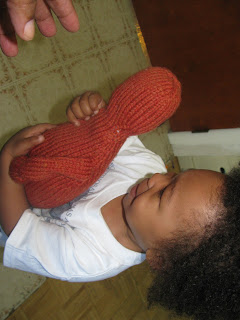Gauge, oh how I dread that word. I hate making gauge swatches and I hate counting gauge even more. I dislike it so much that I usually have someone at my LYS count mine. Now, why do I feel this way? I don’t know. Maybe it is because I never really understood gauge. My lesson last week in Knitting Boot Camp (KBC) was about gauge and blocking.
So, what did I learn about gauge? Knitting gauge refers to the number of stitches and rows in a given area of knitting. To obtain the correct measurements for a garment, you need to obtain the exact number of stitches and rows stated in your pattern. The needle size indicated in the pattern is the one which most knitters use to achieve this gauge with the recommended yarn. However, every knitter knits a little differently and sometimes, even the type of needles, e.g., plastic, wooden, bamboo, or metal, you use can affect your gauge. Ok, I knew that.
Gauge?
So, how do I know what my gauge is? Make a gauge sample starting with the needle size suggested on your yarn label or band. Cast on enough stitches to work a sample at least 5 inches in width. For my samples I cast on 20 stitches and worked in pattern for 5 inches. I made four swatches, stockinette, garter, 2x2 rib, and a seed stitch. I know that some knitting experts tell you not to bind off or measure while the swatch is still on the needles because your stitches can become distorted. Don’t tell anyone but we did bind off and blocked our swatches before measuring. (Don’t report us, please!)

For our stitch gauge, we used a ruler (not a measuring tape) and align it along the left side of a column of stitches in the center portion of your gauge sample. Measure horizontally across by counting the number of stitches across two (if counting two inches you have to double the stitch count) or four inches. Is the number of stitches per inch exactly the same as the stitch gauge specified in your pattern instructions?
For your row gauge, (have never heard of that) we counted the number of rows along two (double again) or four inches vertically down the center of our swatch. Typically, obtaining your row gauge is less important than obtaining the exact stitch gauge since lengthwise portion of garments are usually given as a measurement.
Is your gauge off? What to do?
If you have more stitches than your pattern instructions require then, your knitting is too tight and you need to adjust to larger sized needles. You should work another gauge swatch using the larger sized needles and take another measurement.
If you have fewer stitches than your pattern instructions require then, your knitting is too loose and you need to adjust to smaller sized needles. Again, you should work another gauge swatch using the smaller sized needles and take another measurement.
Keep adjusting your needle size until you’ve achieved the gauge specified in your pattern instructions. In general, changing your needle by 2 sizes adjusts your gauge by 1 stitch. When you’ve obtained the gauge specified in your pattern instructions, write down your needle size you used for reference.
( I got my images from the Internet because my pics look like crap)
 URL: http://www.knitty.com
URL: http://www.knitty.com


































